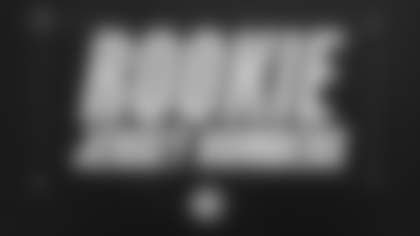(A series looking at the top players at various positions leading up to the 2013 NFL Draft, set for April 25-27.)
This is a good time to be an NFL team in need of help along the offensive line. The quality of the tackles to be available come April 25 could have been historic had a couple of juniors not opted to return to school for their senior seasons, but it's still a deep and talented group. The available guards are such that NFL Network draft analyst Mike Mayock has said he believes the best overall player in this class is a guard. And even though there isn't a Pouncey available to get hearts pumping about the centers, there is a guy there who should end up being voted into the College Football Hall of Fame.
Despite Mayock's opinion, NFL teams just do not pick guards first overall, and that makes it more likely that one of the two available tackles – Texas A&M's Luke Joeckel or Central Michigan's Eric Fisher – will have that honor.
Joeckel (6-foot-6, 306-pounds) won the Outland Trophy and only allowed two sacks last season, and that capped a college career where he started 39 games over three seasons. Nitpickers might point to the fact he spent his final two seasons blocking for one quarterback who became a first-round pick – Ryan Tannehill – and another who was exceptionally athletic and mobile – Johnny Manziel. But most believe that Joeckel has the requisite skills to go along with a desire to be great, and those qualities typically point to a long and distinguished NFL career.
Fisher (6-7, 306) lacked some name recognition because of where he went to college when this process all began back with the college all-star games, but he enters the draft after a four-year career in college that proved he was versatile and dependable. He played in eight games as a freshman in 2009, and then in 2010 he started games at right tackle, right guard, and left tackle. All of his starts in 2011 and 2012 came at left tackle. Fisher raised his game when Central Michigan played the marquee teams on its schedule, but he did have some trouble with Texas' Alex Okafor at the Senior Bowl.
There could be as many as three more tackles who end up being selected before the end of the first round – Oklahoma's Lane Johnson (6-6, 300) and/or Alabama's D.J. Fluker (6-5, 339) as the two most likely candidates – but before they are picked is when the guards might come off the board.
Alabama's Chance Warmack (6-2, 317) is the guy identified by Mayock as the best player in this entire draft class, and there wouldn't be much of an argument over that assessment coming from the front seven of Notre Dame's defense. Over his final three college seasons, Warmack started every game at left guard for the Tide – 40 in all – and he makes up for being a bit short with long arms and excellent strength in his core. Warmack never will look pretty in his uniform, and he'll never grade well when it comes to height/weight/speed tests, but he has a passion for the game and is an intimidating presence in the middle of the line of scrimmage. He has been compared to John Hannah, and no one laughed when it was said.
North Carolina's Jonathan Cooper (6-2, 310) started nine games at left guard in 2009, and over the next three seasons he started 37 games at left guard and one at center. Because of his athleticism and the fact he played at 290 pounds through most of last season, Cooper has drawn some comparisons to Dermontti Dawson and Randall McDaniel, and if he could stay at that weight his best position at the professional level might be at center, which was the exact position switch Dawson made. The one knock on Cooper is a shoulder that already has required some surgery, and his ability to play through the pain that shoulder figures to continue to cause for him moving forward.
The best of the bunch at center is Alabama's Barrett Jones (6-5, 306), who started 25 games at right guard in 2009-10, 11 games at left tackle in 2011, and then 14 games at center in 2012 while winning the Rimington Award. Jones was a fulltime starter on three national championship teams and he's a tough guy – he sustained a Lisfranc injury in the SEC Championship Game vs. Georgia, but he still played in the BCS Championship Game vs. Notre Dame. He had surgery on his foot on Jan. 9, with an expected rehabilitation time of three-to-four months required after that. Whichever team drafts Jones will be getting a fine above-the-neck player who has contributed to a lot of winning.
Lane Johnson actually arrived at Oklahoma as a junior college transfer where he had played quarterback. After being tried at tight end and then defensive end, the Sooners settled on left tackle as his position, and things worked out well. D. J. Fluker showed up at the Senior Bowl weighing a robust 355, and when concerns about him carrying so much weight were expressed to him, he quickly dropped down to 339 for the Combine a couple of weeks later. Another prospect at the position is Oregon's Kyle Long (6-6, 313), the son of Howie Long and the brother of St. Louis defensive end Chris Long.
A couple of other interesting players at the guard spot are Kentucky's Larry Warford (6-3, 335) and Kent State's Brian Winters (6-4, 320). Warford became Kentucky's first Associated Press All-America selection along the offensive line in more than 30 years, and Winters is a former left tackle in college whose physical style seems to be better suited to guard in the NFL.
In addition to Jones at center are Wisconsin's Travis Frederick (6-4, 312) and California's Brian Schwenke (6-3, 314). Frederick originally played left guard for the Badgers, where he was next to Peter Konz, who was the first center picked in the 2012 draft. Once Konz left for the NFL, Frederick moved over to center. Schwenke is a versatile player who has started games at all three interior offensive line positions in college.
THE 2012 NFL DRAFT, OL STATISTICS
Number drafted: Tackles 26; Guards 14; Centers 5
Picks by round: Tackles: 2 in the first; 7 in the second; 3 in the third; 2 in the fourth; 4 in the fifth; 3 in the sixth; 5 in the seventh; Guards: 2 in the first; 0 in the second; 2 in the third; 2 in the fourth; 3 in the fifth; 4 in the sixth; 1 in the seventh; Centers: 0 in the first; 1 in the second; 0 in the third; 2 in the fourth; 0 in the fifth; 1 in the sixth; 1 in the seventh
Highest pick: Tackles: Matt Kalil, USC, Round 1, 4th overall, by Minnesota; Guards: David DeCastro, Stanford, Round 1, 24th overall, by Pittsburgh; Centers: Peter Konz, Wisconsin, Round 2, 55th overall, by Atlanta
Biggest impact: Tackles: Kalil started all 16 games for a Vikings offensive line that helped Adrian Peterson rush for over 2,000 yards; Guards: Kevin Zeitler, a No. 1 pick by Cincinnati (27th overall) started all 16 games for a Bengals team that qualified for the AFC playoffs; Centers: Since there were no rookies to start at center, Konz, with 10 starts for the Falcons at right guard, has to be considered to have had the biggest impact.















